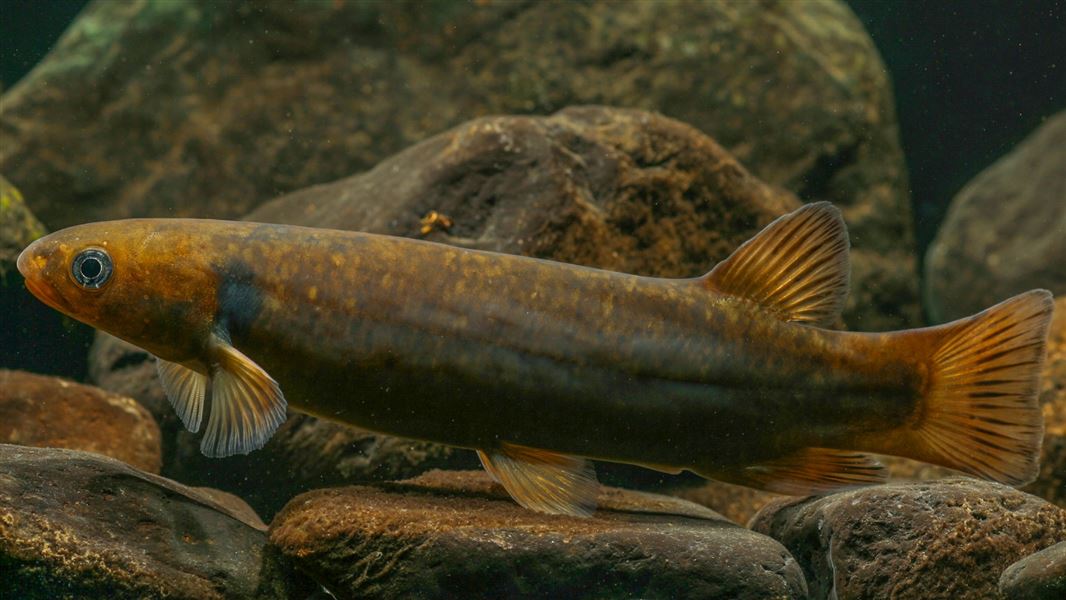New Zealand status: Native
Conservation status: Threatened - Nationally Vulnerable
International conservation status: Least concern (IUCN)
Found in: Rocky forest streams up to 500 m altitude. Present throughout New Zealand but is not usually found on the east coast. Largest populations are in Northland, Taranaki, Wairarapa, Tasman, Marlborough and the South Island’s West Coast.
Threats: Habitat disturbance and modification
Image gallery
About shortjaw kōkopu and other migratory galaxiids
Shortjaw kōkopu (Galaxias postvectis) is one of New Zealand’s five species of migratory galaxiid. The name galaxiid comes from the patterns on the skin of adult fish that look like a galaxy of stars. The other migratory galaxiids are banded kōkopu, giant kōkopu, kōaro and īnanga.
Migratory galaxiids move between streams, rivers and the sea during their lifecycle. Shortjaw kōkopu is one of the species caught as whitebait when juvenile fish enter rivers and streams to begin their upstream migration.
Shortjaw kōkopu is a taonga (treasured) species.
Identifying juvenile and adult fish
Shortjaw kōkopu are named because of their distinctive short lower jaw. It enables the fish to graze on insects from rocks in a stream. Shortjaw kōkopu are also known to feed on insects that fall from stream-side vegetation into the water.
Juvenile shortjaw kōkopu have broad, dark, vertical bands that break up into a marbled pattern as they become adults. Juveniles are 50–60 mm long when they migrate upstream. They are hard to distinguish from kōaro as juveniles because they are a similar size and shape.
The marbled patterning of adult fish ranges from brown to olive green and grey to black, with blue-black pigmentation behind each gill. The front edge of the dorsal fin is forward of the front edge of the anal fin. Adults are usually 150–200 mm long.
Shortjaw kōkopu lifecycle
Eggs are laid beside streams in autumn
Compared with some migratory galaxiids, relatively little is known about where shortjaw kōkopu spawn. Eggs have been found in late autumn at a few sites and spawning is thought to occur from April to July, peaking in May and June. It is likely that adults spawn multiple times throughout their lives.
Eggs are laid in moist leaf litter and gravel on stream banks when the water levels are raised after rain. They develop into larvae over 3–4 weeks if they stay moist and at an even temperature. Eggs may be eaten by predators like eels while submerged and by land-based predators like mice and rats when the stream banks are above water.
Hatching is triggered by re-immersion
In winter, rain again causes stream levels to rise and cover the eggs. This stimulates hatching and the tiny larvae are washed downstream into estuaries or out to sea. Hatching occurs from May to August and peaks in June and July.
Larvae spend 4–6 months in estuaries or at sea, developing into juvenile fish.
Juveniles migrate upstream in spring
By spring, the juvenile fish have grown to about 50 mm in length. They move into rivers and streams and migrate upstream in shallower water near the banks. This occurs from September to November. Juvenile fish grow into adults during the summer.
Adult fish live in streams and rivers
Shortjaw kōkopu live for up to 15 years, possibly longer. Adult fish are usually found in small to medium-sized rivers surrounded by native forest. Their habitat ranges from coastal streams to tributaries of larger rivers up to 500 m above sea level. These fish can climb quite high, steep waterfalls and are known to reach 200 km inland.
During the daytime shortjaw kōkopu hide under riverbanks, fallen logs, large rocks and boulders and in deep fast-flowing pools. At night they feed in pools with a slower flow where they are easier to spot.
Threats to shortjaw kōkopu
Shortjaw kōkopu populations are declining because of many different threats and human activities. These include:
- loss of native forest habitat and the removal of streamside vegetation
- more intensive land use
- poorer water quality and taking water for irrigation
- barriers that prevent fish migrating up and down streams
- whitebait fishing
- competition and predation from introduced fish
- climate change – fish spawning and egg survival are affected by rising temperatures and more frequent and severe storms and droughts.
